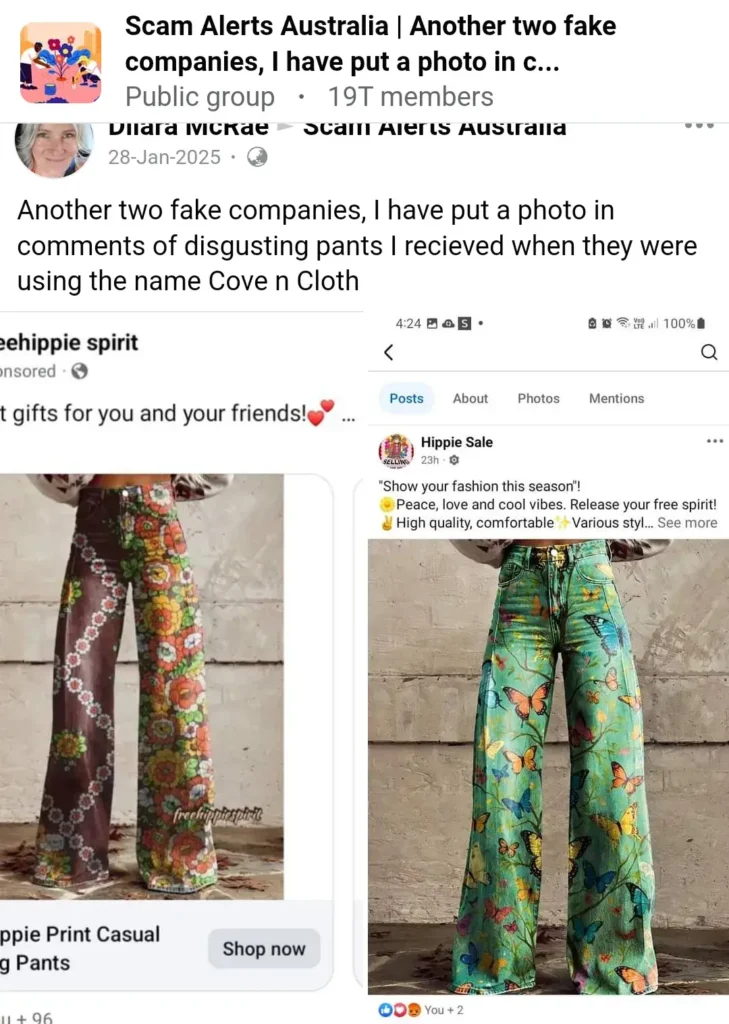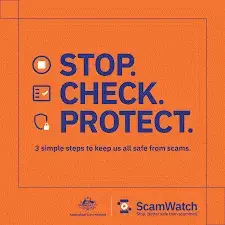Thousands of Australian shoppers are being caught in a digital trap as fake retail websites posing as trusted brands flood social media with slick ads—leaving behind empty parcels, drained PayPal accounts, and a rising wave of consumer frustration.
From so-called “ghost stores” using names like Blue Illusion, Sussan, and Millers, to scam websites hosted on Shopify, the scam websites Australia problem has evolved into a full-blown cyber fraud epidemic.
These fraudulent sites are not just popping up; they’re being pumped into Aussie newsfeeds through Meta scam ads—often with discounts too tempting to ignore. The result? Shoppers lose money, brand reputations suffer, and the online retail space becomes increasingly treacherous.

Image 1: Fake Fashion Websites Mimicking Australian Brands
Source: [Facebook]
Fake Retail Websites: The New Digital Disguise
Modern fake retail websites look frighteningly real. They borrow logos, mimic colour palettes, copy-and-paste product images, and even list ABNs that appear legitimate. Yet once a purchase is made, the goods never arrive—or a counterfeit item is shipped with no return policy in sight.
These ghost stores in Australia are often powered by template platforms like Shopify, which allow anyone with a credit card to set up a storefront within hours.
Experts warn that most of these scam sites disappear within days—only to reappear under a slightly different name, recycling assets from previous victims.
The Role of Social Media: From Friend Feeds to Fraud Funnels
Perhaps most concerning is how scam retailers are gaining traction: through social media scams, especially on Facebook and Instagram.
Brands like Meta have been under fire for failing to properly screen ad buyers. Scam operators often pass identity verification by impersonating small businesses, allowing them to run Facebook scam ads that look as legitimate as any national campaign.
The ads often include:
- Flash sales with “70% off today only”
- Limited stock countdowns
- Fake customer reviews
- Links to high-converting Shopify URLs
Once the victim clicks and checks out, the trail often goes cold.

Image 2: User comments under a scam Facebook ad warning others about the fraud
Source: [ABC NEWS]
Real Cases: Shoppers Speak Out
- A Sydney woman lost $130 after falling for a fake Blue Illusion scam She says the website vanished two days after she ordered.
- Another user in Perth purchased from a Sussan fake store, only to receive a generic scarf that looked nothing like what was advertised.
- A Melbourne retiree was duped by a Millers fraud site, which promised a clearance sale but never delivered the items.
The common thread? Each of these buyers thought they were on a trusted brand’s site, but they were on a lookalike URL hosted overseas and paid via PayPal scam website purchases—with no recourse.
Why Shopify and Meta Are Under Pressure
With scams now running through tech giants’ infrastructure, companies like Shopify and Meta are being called out by cybersecurity experts and regulators for not doing enough to prevent abuse of their platforms.
- Shopify has responded by increasing fraud detection for new store signups but acknowledges that enforcement is difficult.
- Meta says it reviews ads for policy violations, but the volume and sophistication of scams are rising faster than its moderation tools can keep up.
The lack of visibility into who’s behind these “pop-up” stores complicates enforcement and victim compensation.
Scam Prevention Australia: What’s Being Done
Authorities like Scamwatch, the Australian Competition and Consumer Commission (ACCC), and cybersecurity organisations are urging platforms to step up—and consumers to slow down.
Tips from scam prevention experts include:
- Always check for official domain names (e.g., brandname.com.au)
- Avoid ads with urgent countdowns or too-good-to-be-true discounts
- Verify any Shopify store by contacting the official brand
- Use payment methods with strong buyer protection (e.g., credit cards)
- Report suspected scams immediately to Scamwatch and the hosting platform

Image 3: Scamwatch ad graphic showing how to verify a real store
Source: [Scamwatch.gov.au]
PayPal and the Refund Conundrum
While PayPal scam purchases can sometimes be disputed, many victims report mixed success. If the scammer provides a tracking number or claims an item was delivered, PayPal may side with the seller—especially in cross-border cases.
The platform has begun tightening fraud review processes, but as with most cyber scams, prevention is far more effective than recovery.
Conclusion: The Digital Checkout Is No Longer Safe by Default
As brand impersonation scam websites escalate in frequency and sophistication, Australian shoppers must adopt a more defensive mindset online.
The onus also lies with platforms like Meta and Shopify to invest in stronger protections, faster takedowns, and more transparency. Until then, Australians must learn to spot the red flags—because in 2025, clicking “Buy Now” might mean buying into a trap.

